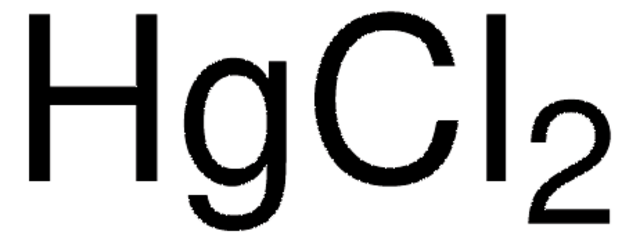215465
Mercury(II) chloride
ACS reagent, ≥99.5%
Synonym(s):
Mercuric chloride
About This Item
acetone: soluble in salt form(lit.)
alcohol: soluble(lit.)
diethyl ether: passes test
ethyl acetate: soluble(lit.)
glycerol: soluble(lit.)
water: soluble(lit.)
Recommended Products
grade
ACS reagent
Quality Level
vapor pressure
1.3 mmHg ( 236 °C)
assay
≥99.5%
form
powder
reaction suitability
reagent type: catalyst
core: mercury
reduction residue
≤0.02%
mp
277 °C (lit.)
solubility
acetic acid: soluble(lit.)
acetone: soluble in salt form(lit.)
alcohol: soluble(lit.)
diethyl ether: passes test
ethyl acetate: soluble(lit.)
glycerol: soluble(lit.)
water: soluble(lit.)
cation traces
Fe: ≤0.002%
SMILES string
Cl[Hg]Cl
InChI
1S/2ClH.Hg/h2*1H;/q;;+2/p-2
InChI key
LWJROJCJINYWOX-UHFFFAOYSA-L
Looking for similar products? Visit Product Comparison Guide
Related Categories
General description
Application
- Addition reaction between aromatic amines to terminal acetylenes to give imines, enamines, and 1,2,3,4-tetrahydroquinoline derivatives.
- Cyclization of amidinothioureas with phenyl hydrazine to produce 3-amino-1,2,4-triazole derivatives.
- Cyclization of O-propargyl glycolaldehyde dithioacetals to afford 3-pyranones along with 2,5-dihydrofuran-3-carboxaldehydes through their dithioketals and dithioacetals reaction.
- Reductive dimerization and cyclization of α,β-unsaturated ketones produce functionalized cyclopentanols using N,N-dimethylformamide as solvent.
signalword
Danger
Hazard Classifications
Acute Tox. 2 Oral - Aquatic Acute 1 - Aquatic Chronic 1 - Muta. 2 - Repr. 2 - Skin Corr. 1B - STOT RE 1
Storage Class
6.1A - Combustible acute toxic Cat. 1 and 2 / very toxic hazardous materials
wgk_germany
WGK 3
flash_point_f
Not applicable
flash_point_c
Not applicable
Choose from one of the most recent versions:
Already Own This Product?
Find documentation for the products that you have recently purchased in the Document Library.
Our team of scientists has experience in all areas of research including Life Science, Material Science, Chemical Synthesis, Chromatography, Analytical and many others.
Contact Technical Service








